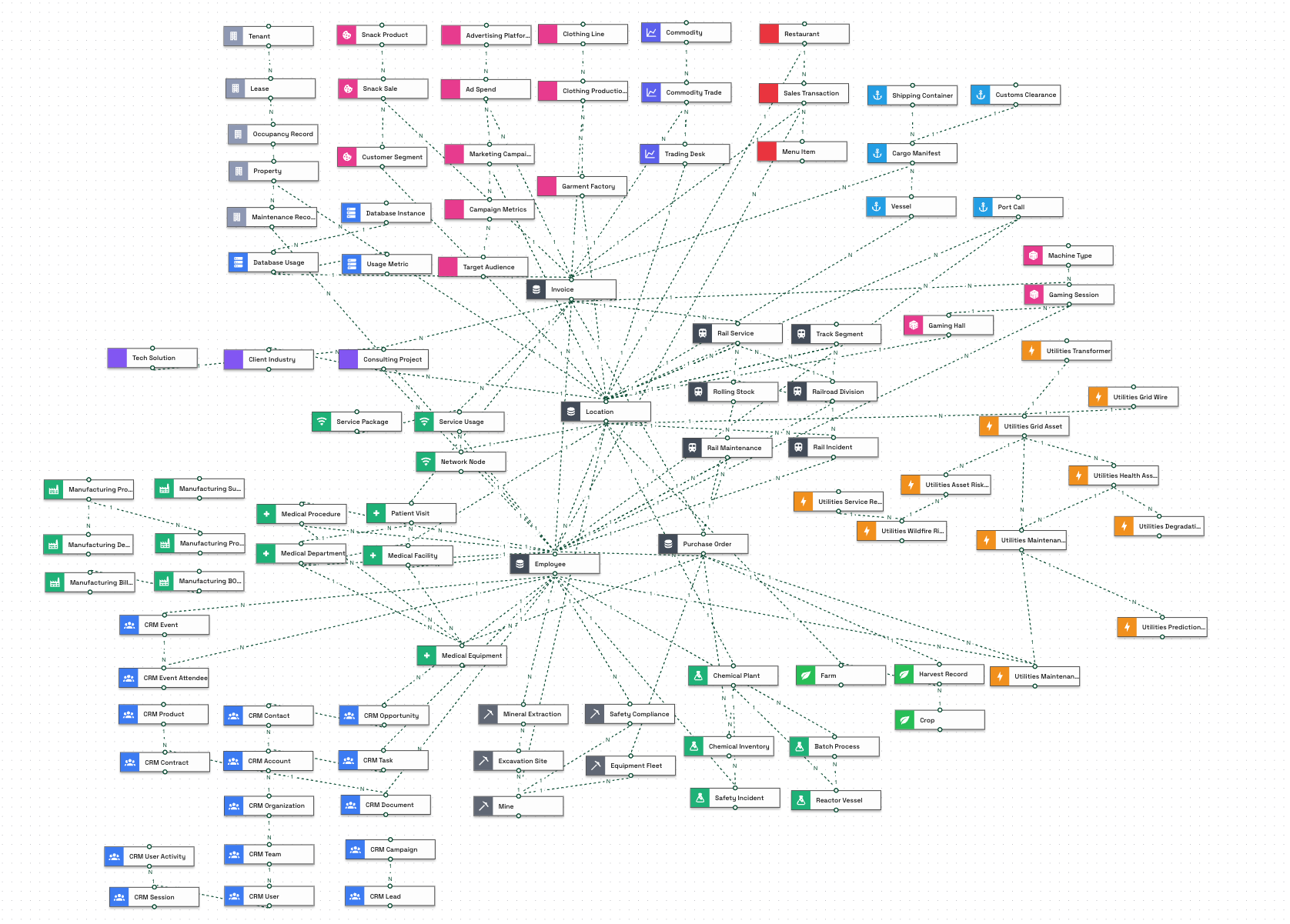
TextQL Conglomerate Ontology
TextQL is working to establish a public environment where prospective customers can interact with the TextQL Conglomerate Ontology on their own. If you or your organization would like access to the Conglomerate Ontology in the meantime, please contact [email protected].
Dataset Description
The TextQL Conglomerate Ontology comprises over 100 objects, organized into 12 distinct domains (such as Digital Marketing, Garment Manufacturing, Snack Sales (CPG), etc.). Each domain contains between 3 and 10 objects, tailored to represent specific business areas and data sources. At the heart of the ontology lie four Core Objects that are shared across all domains and enable cross-domain analysis:- Location: Basic geographical information for all other entities
- Employee: Staff records with roles and salaries
- Purchase Order: Tracks outgoing and incoming purchases
- Invoice: Financial records linked to various transactions
- Employee salary trends by role and location
- Invoice amounts and frequency by business unit
- Geographic distribution of operations
Subsidiary Domains and Data
Commodities Trading
- Objects
- Key Metrics
- Trends to Look For
- Sample Questions
- TradingDesk: Regional trading operations offices
- Commodity: Traded materials (e.g., Crude Oil, Natural Gas, Gold)
- CommodityTrade: Individual trading transactions
Digital Marketing
- Objects
- Key Metrics
- Trends to Look For
- Sample Questions
- MarketingCampaign: Marketing initiatives
- AdvertisingPlatform: Ad platforms (Google, Meta, etc.)
- TargetAudience: Demographic segments
- AdSpend: Advertising expenditure
- CampaignMetrics: Performance metrics
Communications Provider
- Objects
- Key Metrics
- Trends to Look For
- Sample Questions
- NetworkNode: Physical infrastructure
- ServicePackage: Service offerings
- ServiceUsage: Usage metrics and quality
Cloud Database Usage
- Objects
- Key Metrics
- Trends to Look For
- Sample Questions
- DatabaseInstance: Cloud databases
- UsageMetric: Usage measurements
- DatabaseUsage: Actual usage records
Gaming Operations
- Objects
- Key Metrics
- Trends to Look For
- Sample Questions
- GamingHall: Physical gaming locations
- MachineType: Gaming equipment types
- GamingSession: Individual play sessions
Garment Manufacturing
- Objects
- Key Metrics
- Trends to Look For
- Sample Questions
- GarmentFactory: Production facilities
- ClothingLine: Product collections
- ClothingProductionBatch: Production runs
Snack Sales (CPG)
- Objects
- Key Metrics
- Trends to Look For
- Sample Questions
- SnackProduct: Product catalog
- CustomerSegment: Consumer demographics
- SnackSale: Sales transactions
Utilities
- Objects
- Key Metrics
- Trends to Look For
- Sample Questions
- Service Region: Geographic regions of service coverage
- Wildfire Risk Zone: Areas monitored for fire risk
- Grid Asset: Base infrastructure (transformers, wires, etc)
- Transformer: Specialized power transformer equipment
- Grid Wire: Power line infrastructure
- Asset Risk Zone: Maps assets to risk zones
- Health Assessment: Equipment health checks
- Degradation Factor: Issues found in health checks
- Maintenance Prediction: Predicted maintenance needs
- Prediction Risk Factor: Risk factors for predictions
- Maintenance Order: Work orders for maintenance
Healthcare Operations
- Objects
- Key Metrics
- Trends to Look For
- Sample Questions
- MedicalFacility: Hospitals, clinics, labs, and pharmacies
- Department: Organizational units within facilities
- MedicalEquipment: Medical devices and tools
- PatientVisit: Patient encounters and visits
- Procedure: Medical procedures performed
Railroad Operations
- Objects
- Key Metrics
- Trends to Look For
- Sample Questions
- RailroadDivision: Operational divisions (Freight/Passenger)
- RollingStock: Trains and cars
- TrackSegment: Rail infrastructure
- RailService: Scheduled services
- RailMaintenance: Maintenance records
- RailIncident: Safety and operational incidents
B2B SaaS CRM (Customer Relationship Management)
- Objects
- Key Metrics
- Trends to Look For
- Sample Questions
- CrmOrganization: Parent companies and partners (with type, size, location)
- CrmAccount: Business units within organizations (with tier, revenue, industry)
- CrmContact: Individual stakeholders (with role, level, decision-making power)
- CrmContract: Legal agreements and renewals
- CrmCampaign: Marketing initiatives and programs
- CrmEvent: Customer meetings, trainings, and conferences
- CrmEventAttendee: Event participation tracking
- CrmDocument: Contracts, proposals, and legal documents (with versions, formats)
- CrmLead: Potential sales opportunities
- CrmOpportunity: Sales pipeline tracking
- CrmProduct: Product catalog and pricing
- CrmTeam: Internal organizational units
- CrmUser: System users and their activities
- CrmUserActivity: Detailed user interaction logs
- CrmSession: User login sessions
- CrmTask: Work items and assignments
Furniture Manufacturing & Retail System
- Objects
- Key Metrics
- Trends to Look For
- Sample Questions
- FurnitureProduct: Products with categories, descriptions, and pricing
- FurnitureBillOfMaterials: Manufacturing recipes and component structures
- FurnitureSupply: Raw materials and supplies used in manufacturing
- FurnitureBomComponent: Components used in product assembly
- FurnitureProductBomComponent: Product-based assembly components with quantities
- FurnitureSupplyBomComponent: Supply-based components with quantities
- FurnitureOrder: Customer orders with channel and timing information
- FurnitureProductOrder: Product-specific order details with quantities
- FurnitureDemandPlan: Production planning and forecasting